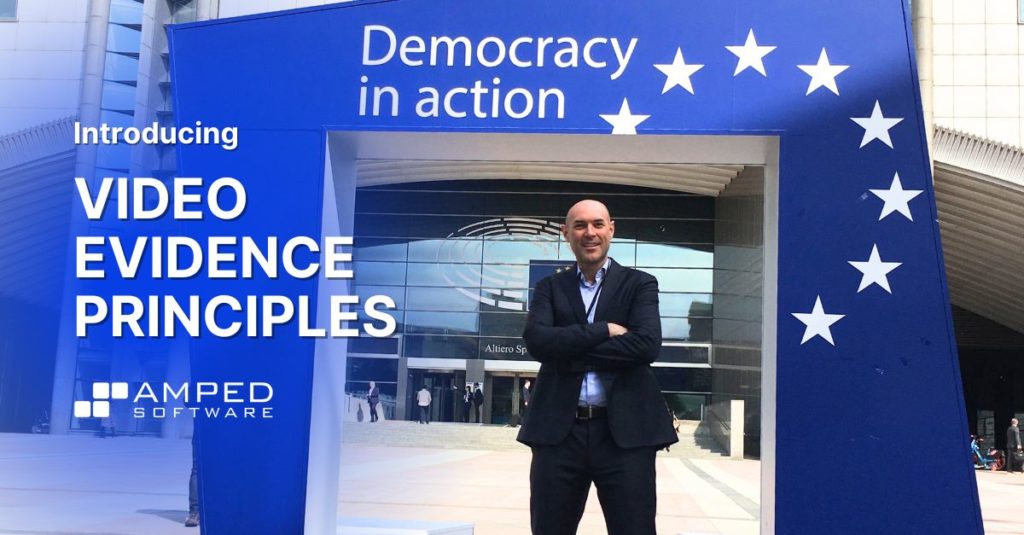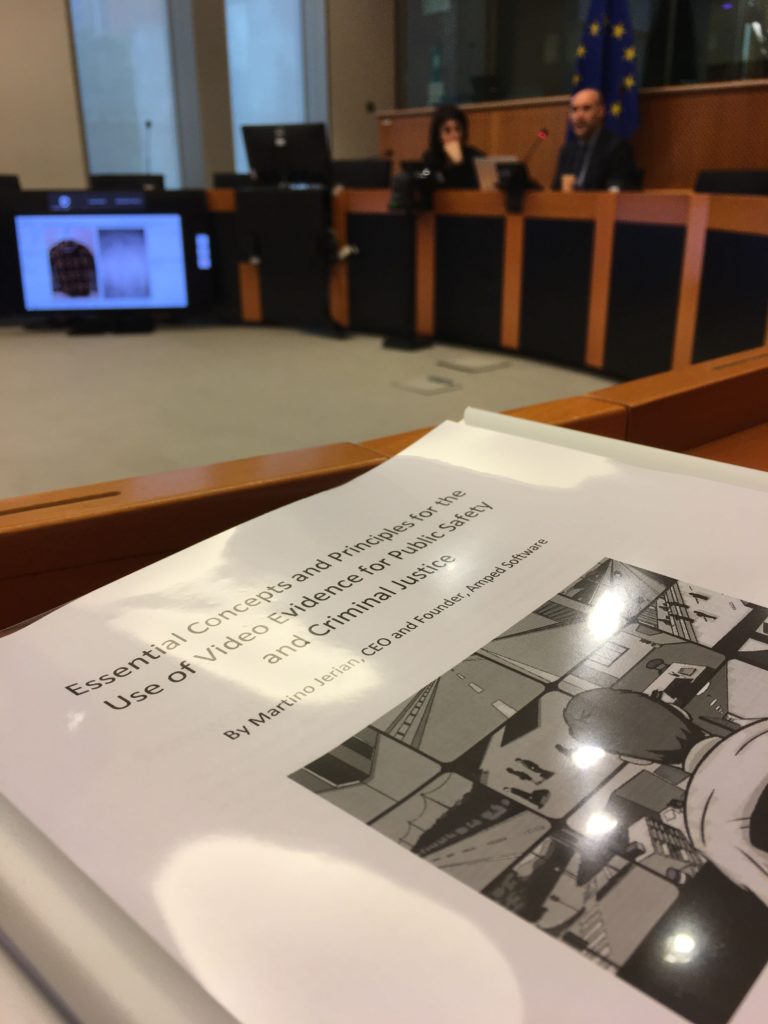
Images and videos are among the most commonly available and powerful evidence. However, the complexity and challenges that surround them are often not well understood or properly considered during investigations and criminal proceedings. In order to create more awareness among practitioners and institutions on the topic and improve security and justice in our communities, we prepared a document outlining key concepts essential for working with video evidence. On May 24, 2023 I had the opportunity to organize a meeting and present the video evidence principles at the European Parliament. Read on to learn more.
Everybody is a stakeholder
When I started Amped Software, I focused entirely on a very high-knowledge user base: the forensic video analyst whose main job is to deal technically with images and videos during investigations and in court. I had this target user in mind when I created Amped FIVE. Together with the software, we designed training that – while appropriate for users with a wide range of skill levels – aimed at educating the more specialized users on video evidence.
Conversely, a product such as Amped Replay, doesn’t even need training to be used. However, we couple it with a course called Investigating Video Evidence. This focuses on educating non-technical users and investigators on the most important factors to consider when working with video evidence.
The interesting thing between the typical user of Amped FIVE (let’s call them “the analyst”) and the typical user of Amped Replay (“the investigator”) is that they are working exactly on the same kind of footage, with the same issues, but their focus is different. The analyst usually has deep technical competency and can dedicate quite some time to a specific case. The investigator has to deal with video together with many other completely different activities, often on the field. They need to sort out issues quickly, often without much technical preparation. For this reason, it is vital to distinguish between tasks suitable for investigators and those that should be escalated to analysts. This is one of the reasons why we launched the integration between FIVE and Replay earlier this year.
While expanding our user base and training from the relatively few analysts to a broader number of investigators and police officers, we realized that educating just them on the potential and the challenges of image and video evidence was not enough. The stakeholders of the criminal justice system are many more: judges, attorneys, prosecutors, journalists, juries, law enforcement chiefs, and ultimately everybody of us.
The need to work with science
A number of scientific studies clearly show that image and video evidence is more often available and more effective than any other kind of digital or physical evidence.
At the same time, understanding the facts of the evidence may seem “easy” to the public. Why do you need specialized personnel and tools, when everybody can watch a video with their eyes and make a dark picture brighter on their mobile phone?
However, because of the limitations of technology and “shortcuts” our eyes and brains take while viewing footage, it’s very easy to underestimate the complexity of the evidence and drive the investigation on the wrong path, or condemn an innocent.
The first step then, is to raise awareness. To solve a problem, we need first to understand that a problem exists. When armchair investigators claim to see more than experts and “enhance” images downloaded from Twitter fostering conspiracy theories, we clearly see there’s a cultural concern.
In general, we need to treat image and video evidence as any other scientific forensic discipline, following guidelines and practices which allow a correct, repeatable, and reproducible workflow. We have excellent quality guidelines, such as those from ENFSI, SWGDE, OSAC, and the UK FSR. They should be more widely adopted, followed, and further developed.
Video Evidence Principles
One year ago, I organized a meeting at the European Parliament titled “Video Evidence: don’t take it for granted”. Its simple objective was to say, “Hey, maybe you don’t know, but we have some problems here”. The meeting sparked a lot of interest. One of the deliverables I committed to for this year was to propose a set of principles to disseminate to member and non-member states.
After quite some work, with the help and contributions of several colleagues and industry experts who reviewed and commented on the document, I finalized a document titled “Essential Concepts and Principles for the Use of Video Evidence for Public Safety and Criminal Justice” (click on the link to download the document).
This document summarizes my professional experience and dedication to this industry for over 15 years. I believe this will bring significant benefits for our society. That said, it’s just a first step to improving the recognition and foundations of our industry, especially for people that are not inside it but are its stakeholders.
To publicly present this document, I organized another meeting at the European Parliament last week, on May 24th, 2023. This time it was in the form of a high-level roundtable, with the objective of fostering discussion on the topic. We had a lot of very interesting conversations with the attendees, to the point where we went well beyond the scheduled meeting time.

The document is divided into two separate sections. The first section is specifically aimed at policymakers and all the stakeholders of the public safety and justice system. It makes them aware of some very high-level concepts that they should take into account when dealing with cases involving image and video evidence. The second section is aimed at practitioners (such as investigators and analysts) of the image and video forensics discipline and contains the actual principles.
These principles should not be considered a replacement for the above-mentioned guidelines, already written and approved by the industry, or for organizational-specific SOPs (standard operating procedures). The principles cover topics from a much higher level. I consider them almost a form of overview, a first step to getting into the more specific and already existing documents.
Feel free to disseminate and share this document as much as possible. If you have any comments or suggestions to improve the principles, feel free to reach out to me.




